Mystery and Excellence on The Human Body - Strength
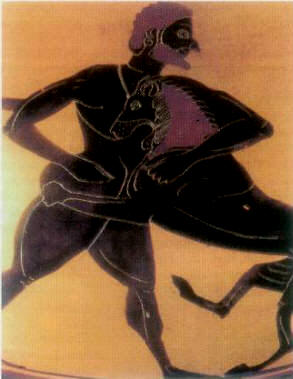
The Greek hero Heracles slaying the Nemean lion
Strength
Introduction
Man, and particularly modern man, is the weakest of the large animals. If he has come to dominate the terrestrial creation it is by the power of his mind rather than the strength of his frame. And yet, at the beginning of his long journey on Earth, sheer physical strength was an essential condition of his survival; prehistoric humans ran long distances in search of fire or food and were able to kill animals much larger than themselves. Only the strong tended to survive.
As societies developed and men's activities diversified, strength became the goal of specialized members of society such as the manual labourer, the fighter or the athlete. In the modern world where automation has replaced the labourer and sophisticated weaponry the foot soldier, physical strength is no longer a necessity for survival. Yet the desire for strength has not abated in man and sports offers now the main arena where the wondrous capacities of the body can be expressed.
Of course, the stadium or the boxing ring are only for the few. But the many, though no longer in need of strength of body, are perhaps secretly longing for it: the growing popularity of sports like weight lifting, boxing, wrestling, body-building, bears witness to the attraction still exerted by strength.
The main attributes that one should develop in regard to one's body are: health, strength, endurance, speed, lightness, grace and beauty. All these attributes are, in a sense, interdependent, but strength occupies a special place. Without strength, the health of the body can easily deteriorate; the real basis of endurance is strength; strength is the fundamental
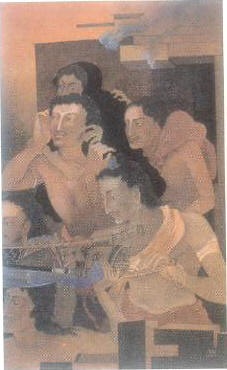
Bhima ready to lift his family on his shoulders (Jatugriha Daha: Nandalal Bose). This refers to an episode of the Mahabharata when the Pandavas escape from "the house of lac" which has been set on fire. Bhima is shown here as carrying his mother Kunti. (Courtesy: NGMA, New Delhi)
force behind speed; it is only the strong who can feel the lightness of the body without weakness; strength combined with grace and beauty bestows perfection. It gave rise to powerful myths like Heracles and Bhima. The image of Bhima carrying his mother and four brothers through the forest strikes us as an archetype of strength. If man is in awe of the feats of Bhima, he also aspires to emulate him; for it was discovered long ago that the body is not just a piece of matter more or less endowed with strength, it is perfectible. Already in ancient India, a regular training system was devised using specific methods to bring about sizeable changes in body strength and power. "Professional wrestlers built up their bodies and developed their strength like demons!" says an ancient Indian text. Wrestlers ran long distances and swam long distances, carried around heavy weights, tried to restrain young bulls. They wielded wooden or iron clubs of varying weight to exercise arms and shoulders. Later they would use stone cubes or stone wheels fitted with a handle to grip. They would repeatedly
lift sand bags with either hands or legs long before barbells were invented.
The ancient Greeks also put a great emphasis on the body. They worshipped Health, Beauty and Strength. Mythical heroes of fabulous strength like Atlas or Heracles were emulated in real life by characters almost as formidable. Milo of Crotona, a wrestler who lived around 500 B.C., was said to have developed his strength by carrying a calf every day of its life until it was a full grown bull? (He thus may be the real inventor of the modern notion of "progressive resistance training "). People loved him for his tricks: he would hold a pomegranate so fast in his fist that no one could get it from him, and yet the fruit would remain unharmed. Or he would stand on an oiled quoit and resist all efforts to dislodge him. His strength went along with an enormous appetite — he could eat a four-year heifer in one day!
Today we still feel the fascination with strength that the watchers of Milo experienced, but widespread information and numerous training facilities have made of strength a goal accessible to all. Modern knowledge about the body has helped perfect the training methods devised by early man in his quest for strength, but whereas in the olden times only
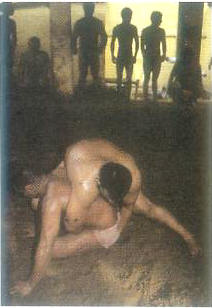
A view of an Indian akhada or wrestling school
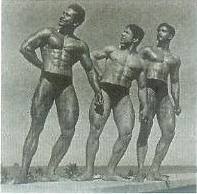
Body-building at the Sri Aurobindo Ashram, 1958
wrestlers and fighters would train their muscles systematically, today many athletes, tennis players, sprinters, football players, jumpers, etc., use the principles of weight training to achieve better results in their own disciplines.
Man's constant striving for strength has led to a seemingly endless progress. The human body is stronger than ever before, lifts more weight, throws more weight farther than ever before and keeps breaking its own records. The perennial desire for strength touches chords in every human being. In thousands of stories and films the hero is strong. With his strength he courageously serves justice and truth and defeats evil ways. Such a strength is highly desirable. In today's world, we can see humanity changing its old views on the body: it is no longer an awkward appendage to the spirit or an unconscious cloak to be left to doctors when it is malfunctioning — it is an integral part of the human person and like our habits or our character can be worked upon and changed.
The example of a great champion is always inspiring and the following excerpts from the autobiography of the man who brought body building widespread recognition will help the reader understand the psychology and dedication that allow the weak to become strong and the strong to become even stronger.
Of course, we are aware that body-building is a controversial activity as it can become an excessive preoccupation leading to excesses which contribute to the mixed reputation it enjoys. Examples of monstrous build-up of muscles which can be seen in some specialised magazines may lead quite a few to a wholesale rejection of this sport. We nevertheless felt that Arnold Schwarzenneger is an authentic sportsman and champion and that the remarkable capacity for discipline and control which he has been able to develop is worth admiring. It is why we are presenting these excerpts from Arnold: The Education of a Body-Builder.
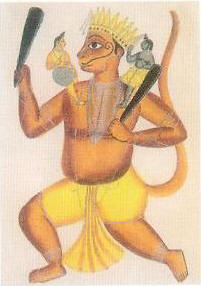
Hanuman, carrying on his shoulders Lord Rama and his brother Lakshman. Hanuman is the patron god of the Indian wrestlers.
Related Books
- Alexander the Great
- Arguments for The Existence of God
- But it is done
- Catherine The Great
- Danton
- Episodes from Raghuvamsham of Kalidasa
- Gods and The World
- Homer and The Iliad - Sri Aurobindo and Ilion
- Indian Institute of Teacher Education
- Joan of Arc
- Lenin
- Leonardo Da Vinci
- Lincoln Idealist and Pragmatist
- Marie Sklodowska Curie
- Mystery and Excellence on The Human Body
- Nachiketas
- Nala and Damayanti
- Napoleon
- Parvati's Tapasya
- Science and Spirituality
- Socrates
- Sri Krishna in Brindavan
- Sri Rama
- Svapnavasavadattam
- Taittiriya Upanishad
- The Aim of Life
- The Crucifixion
- The Good Teacher and The Good Pupil
- The Power of Love
- The Siege of Troy
- Uniting Men - Jean Monnet